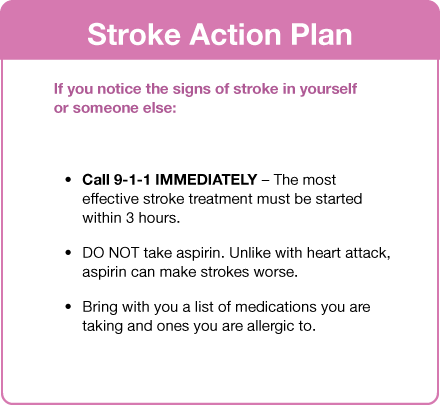Action Plan

Know the Symptoms
To insure you receive prompt treatment and have the best chance for a positive outcome, it is crucial that both you and your loved ones know how to recognize stroke symptoms before anything happens. Since stroke is a brain injury, someone who has suffered one may be confused and unable to take the necessary steps themselves.
For a complete rundown of symptoms of stroke and mini-stroke, as well as how to recognize a stroke in someone else, see our article on Stroke Signs.
Act Quickly
If you experience any signs of stroke, don’t wait. Call 9-1-1 right away. When it comes to stroke, “time lost is brain lost.” The longer you wait to get medical treatment, the more brain damage will occur, and the lower your chances of surviving and making a full recovery will be. Stroke can be treated, but only if you get help quickly.
The rule to remember is that stroke needs to be treated within 3 hours of when the symptoms first started to occur. The most effective therapy for blocked-vessel (ischemic) stroke (the most common kind of stroke) is clot-busting drugs (tPA) that break up the blockage and allow blood and oxygen to get back to the affected part of your brain. However, these drugs must be given within 3 hours of the start of a stroke to work, and you’ll need to have tests done at the hospital first.
Most people who experience a stroke wait far too long to seek medical help, causing them to miss out on the most effective treatments. Overall, research indicates that women and men who suffer a stroke have similar delays in getting to a hospital.1 Some evidence suggests, however, that tPA may be used less in women compared with men, possibly due to delays once they get to the hospital.2
Talk with your family and friends about signs of stroke and the importance of acting fast by calling 9-1-1. It is important to call emergency services because research shows that people who call an ambulance are more likely to receive treatment in time.3 Calling your primary care physician first or having someone drive you to the hospital can delay your treatment.4
Below are some additional preparations you can make; however, you should not lose precious time searching for anything before calling 9-1-1.
Information to Have Available
Find out the location of the nearest hospital that offers 24-hour emergency stroke care and keep the address handy. Click here to search for JCAHO-certified Primary Stroke Centers in your state. Click here for instructions on how to search if you are having trouble.
You should also keep a list of medications you are taking and ones you are allergic to. This will help ensure that you receive the appropriate treatments.
See also:
Overview of Stroke, including the effects of a stroke and how it is diagnosed and treated
References
- Moser DK, Kimble LP, Alberts MJ, et al. Reducing delay in seeking treatment by patients with acute coronary syndrome and stroke: a scientific statement from the American Heart Association Council on cardiovascular nursing and stroke council. Circulation. 2006;114:168-182.
- Lisabeth LD, Brown DL, Morgenstern LB. Barriers to intravenous tissue plasminogen activator for acute stroke therapy in women. Gend Med. 2006;3:270-278.
- Mandelzweig L, Goldbourt U, Boyko V, Tanne D. Perceptual, social, and behavioral factors associated with delays in seeking medical care in patients with symptoms of acute stroke. Stroke. 2006;37:1248-1253.
- Wester P, Radberg J, Lundgren B, Peltonen M. Factors associated with delayed admission to hospital and in-hospital delays in acute stroke and TIA: a prospective, multicenter study.Seek- Medical-Attention-in-Time Study Group. Stroke. 1999;30:40-48.



